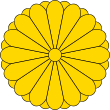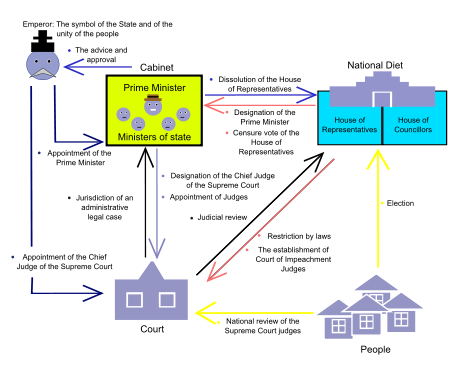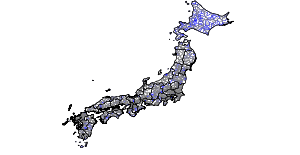- Government of Japan
-
Japan 
This article is part of the series:
Politics and government of
JapanConstitutionGovernmentJudiciaryPrefectures- Prefectures
- Governors (list)
ElectionsForeign relations
The government of Japan is a constitutional monarchy where the power of the Emperor is very limited. As a ceremonial figurehead, he is defined by the 1947 constitution as "the symbol of the state and of the unity of the people". Power is held chiefly by the Prime Minister of Japan and other elected members of the Diet, while sovereignty is vested in the Japanese people.[1] The Emperor effectively acts as the head of state on diplomatic occasions. Akihito is the current Emperor of Japan. Naruhito, Crown Prince of Japan, stands as next in line to the throne.
Japan's legislative organ is the National Diet, a bicameral parliament. The Diet consists of a House of Representatives, containing 480 seats, elected by popular vote every four years or when dissolved and a House of Councillors of 242 seats, whose popularly elected members serve six-year terms. There is universal suffrage for adults over 20 years of age,[2] with a secret ballot for all elective offices.[1] In 2009, the social liberal Democratic Party of Japan took power after 54 years of the liberal conservative Liberal Democratic Party's rule.
The Prime Minister of Japan is the head of government. The position is appointed by the Emperor of Japan after being designated by the Diet from among its members and must enjoy the confidence of the House of Representatives to remain in office. The Prime Minister is the head of the Cabinet (the literal translation of his Japanese title is "Prime Minister of the Cabinet") and appoints and dismisses the Ministers of State, a majority of whom must be Diet members. Yoshihiko Noda currently serves as the Prime Minister of Japan.[3]
Historically influenced by Chinese law, the Japanese legal system developed independently during the Edo period through texts such as Kujikata Osadamegaki. However, since the late nineteenth century, the judicial system has been largely based on the civil law of Europe, notably France and Germany. For example, in 1896, the Japanese government established a civil code based on the German model. With post–World War II modifications, the code remains in effect in present-day Japan.[4] Statutory law originates in Japan's legislature, the National Diet of Japan, with the rubber stamp approval of the Emperor. The current constitution requires that the Emperor promulgates legislation passed by the Diet, without specifically giving him the power to oppose the passing of the legislation.[1] Japan's court system is divided into four basic tiers: the Supreme Court and three levels of lower courts.[5] The main body of Japanese statutory law is a collection called the Six Codes.[4]
Contents
National government
Legislative branch
Main article: Diet of JapanThe National Diet of Japan is Japan's legislature. It consists of two houses: the House of Representatives of Japan and the House of Councillors. Both houses of the Diet are directly elected under a parallel voting system.
The Diet has the legislative function of tabling and passing of Bills. It has several powers not given to but is voted down by the House of Councillors, the House of Representatives can override the decision of the other chamber. In the case of treaties, the budget, and the selection of the prime minister, however, the House of Councillors can only delay passage, but not block the legislation.
House of Councillors
Of the 242 members in the House of Councillors, 146 are elected from 47 prefectural constituencies by means of the Single Non-Transferable Vote. The remaining 96 are elected by party list PR from a single national list.
Executive branch
The executive branch reports to the Diet. The chief of the executive branch, the Prime Minister, is appointed by the Emperor as directed by the Diet. He must be a member of either house of the Diet and a civilian. The Cabinet, which he organizes, must also be civilian. The Constitution states that the majority of the Cabinet must be elected members of either house of the Diet, the precise wording leaving an opportunity to appoint non-elected officials.
Prime Minister
Main article: Prime Minister of JapanYoshihiko Noda (since 2 September 2011)
Cabinet
Main article: Cabinet of JapanMinistries
Main article: Ministries of JapanCabinet Office (National Public Safety Commission) Internal Affairs and Communications | Justice | Foreign Affairs | Finance | Education | Health | Agriculture | Economy | Land, Infrastructure, Transport and Tourism | Environment | Defense
Judicial branch
Consists of several levels of courts, with the Supreme Court, as drawn up on May 3, 1947, includes a bill of rights similar to the United States Bill of Rights, and the Supreme Court has the right of judicial review. Japan does not have administrative courts or claims courts, and the jury system has only come into use relatively recently. Because of the judicial system's basis, court decisions are the final judicial authority.
The judicial branch is independent of the other two. Its judges are appointed by the Emperor as directed by the Cabinet.
Local government
Administrative divisions of Japan Prefectural level Prefectures
(都道府県 todōfuken)Subprefectural level Subprefectures
(支庁 shichō)
Municipal level Designated cities
(政令指定都市 seirei-shitei-toshi)
Special cities
(特例市 tokurei-shi)
Special wards (Tokyo)
(特別区 tokubetsu-ku)
Sub-municipal level Wards
(区 ku)Japan has a unitary system of government in which local jurisdictions largely depend on national government financially. The Ministry of Internal Affairs and Communications intervenes significantly in local government, as do other ministries. This is done chiefly financially because many local government jobs need funding initiated by national ministries. This is dubbed as "thirty-percent autonomy."[6]
The result of this power is a high level of organizational and policy standardization among the different local jurisdictions allowing them to preserve the uniqueness[citation needed] of their prefecture, city, or town. Some of the more collectivist jurisdictions, such as Tokyo and Kyoto, have experimented with policies in such areas as social welfare that later were adopted by the national government.
Local authorities
Japan is divided into forty-seven administrative divisions, the prefectures: one metropolitan district (Tokyo), two urban prefectures (Kyoto and Osaka), forty-three rural prefectures, and one "district", Hokkaidō. Large cities are subdivided into wards, and further split into towns, or precincts, or subprefecture and counties.
Cities are self-governing units administered independently of the larger jurisdictions within which they are located. In order to attain city status, a jurisdiction must have at least 30,000 inhabitants, 60 percent of whom are engaged in urban occupations. There are self-governing towns outside the cities as well as precincts of urban wards. Like the cities, each has its own elected mayor and assembly. Villages are the smallest self-governing entities in rural areas. They often consist of a number of rural hamlets containing several thousand people connected to one another through the formally imposed framework of village administration. Villages have mayors and councils elected to four-year terms.
Structure of local government
All prefectural and municipal governments in Japan are organized following the Local Autonomy Law, a statute applied nationwide in 1947.
Each jurisdiction has a chief executive, called a governor (知事 chiji) in prefectures and a mayor (長 chō) in municipalities. Most jurisdictions also have a unicameral assembly (議会 gikai), although towns and villages may opt for direct governance by citizens in a general assembly (総会 sōkai). Both the executive and assembly are elected by popular vote every four years.
Local governments follow a modified version of the separation of powers used in the national government. An assembly may pass a vote of no confidence in the executive, in which case the executive must either dissolve the assembly within ten days or automatically lose their office. Following the next election, however, the executive remains in office unless the new assembly again passes a no confidence resolution.
The primary methods of local lawmaking are local ordinance (条例 jōrei) and local regulations (規則 kisoku). Ordinances, similar to statutes in the national system, are passed by the assembly and may impose limited criminal penalties for violations (up to 2 years in prison and/or 1 million yen in fines). Regulations, similar to cabinet orders in the national system, are passed by the executive unilaterally, are superseded by any conflicting ordinances, and may only impose a fine of up to 50,000 yen.
Local governments also generally have multiple committees such as school boards, public safety committees (responsible for overseeing the police), personnel committees, election committees and auditing committees. These may be directly elected or chosen by the assembly, executive or both.
All prefectures are required to maintain departments of general affairs, finance, welfare, health, and labor. Departments of agriculture, fisheries, forestry, commerce, and industry are optional, depending on local needs. The governor is responsible for all activities supported through local taxation or the national government.
See also
- Civil service of Japan
- Government-business relations in Japan
- Japanese public corporations
- List of Japanese government and military commanders of World War II
- Hideyo Noguchi Africa Prize
References
- ^ a b c "The Constitution of Japan". House of Councillors of the National Diet of Japan. 1946-11-03. http://www.sangiin.go.jp/eng/law/index.htm. Retrieved 2007-03-10.
- ^ "World Factbook; Japan". CIA. 2007-03-15. https://www.cia.gov/library/publications/the-world-factbook/geos/ja.html. Retrieved 2007-03-27.
- ^ "Prime Minister of Japan and His Cabinet". Office of the Prime Minister of Japan. http://www.kantei.go.jp/foreign/index-e.html. Retrieved 2008-09-23.
- ^ a b "Japanese Civil Code". Encyclopædia Britannica. 2006. http://www.britannica.com/eb/article-9043364?hook=6804. Retrieved 2006-12-28.
- ^ "The Japanese Judicial System". Office of the Prime Minister of Japan. http://www.kantei.go.jp/foreign/judiciary/0620system.html. Retrieved 2007-03-27.
- ^ 三割自治 san wari jichi
Governments of Asia Sovereign
states- Afghanistan
- Armenia
- Azerbaijan
- Bahrain
- Bangladesh
- Bhutan
- Brunei
- Burma (Myanmar)
- Cambodia
- People's Republic of China
- Cyprus
- East Timor (Timor-Leste)
- Egypt
- Georgia
- India
- Indonesia
- Iran
- Iraq
- Israel
- Japan
- Jordan
- Kazakhstan
- North Korea
- South Korea
- Kuwait
- Kyrgyzstan
- Laos
- Lebanon
- Malaysia
- Maldives
- Mongolia
- Nepal
- Oman
- Pakistan
- Philippines
- Qatar
- Russia
- Saudi Arabia
- Singapore
- Sri Lanka
- Syria
- Tajikistan
- Thailand
- Turkey
- Turkmenistan
- United Arab Emirates
- Uzbekistan
- Vietnam
- Yemen
States with limited
recognition- Abkhazia
- Nagorno-Karabakh
- Northern Cyprus
- Palestine
- Republic of China (Taiwan)
- South Ossetia
Dependencies and
other territoriesCategories:- Subdivisions of Japan
- Government of Japan
- Prefectures
Wikimedia Foundation. 2010.


